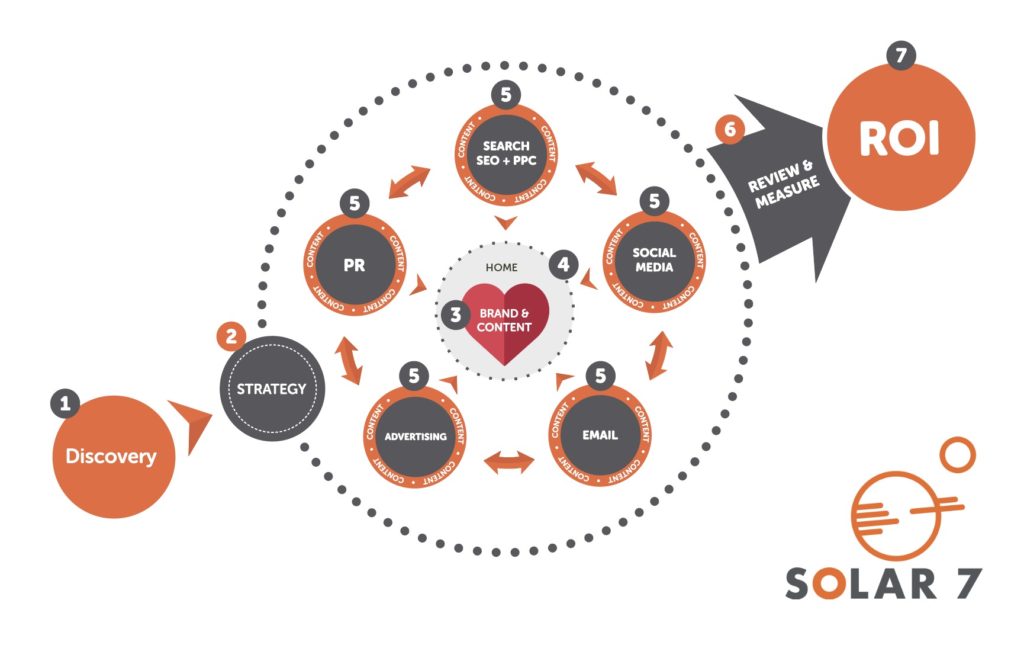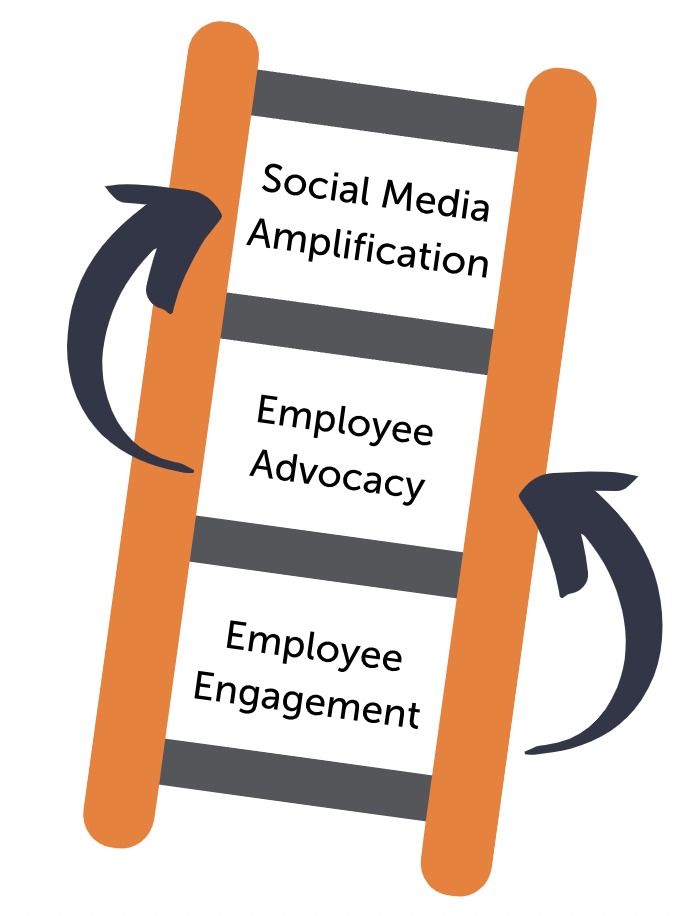Did you know that 1 unengaged employee on an average salary of £35,000 would cost a business £7,000? (Perkbox) and, that 3 in 5 employees are disengaged in the UK? (Robert Walters).
Scary isn’t it?
As a business owner, you must ensure your employees stay engaged. However, is a ‘happy’ employee enough? Could you, and should you be doing more?
Recruitment and retention are quickly becoming a pain point for a lot of businesses. In this webinar, our Digital Marketing Manager, Danni Johnson and Sally Bendtson from Limelight HR teamed up to discuss what more you can do to achieve success with your employees, both in the workplace and out of it.
You might think you have a really engaged team, but can you confidently say they would be advocates for your brand?
In a world of rising social media usage, financial crisis and changing perceptions, your employees demand more from you, as do your potential applicants. If you don’t focus on your employees now, there’s a chance you’ll get left behind.
In this webinar they discussed:
- The 3 key areas companies need to understand from an HR perspective in order to build a successful business that people love working in
- How and why engaged employees are a vital part of your marketing strategy
- What Employee Advocacy is and what you should be doing in your business to promote it
About the speakers:
Sally Bendtson is the Founder of Limelight HR, author of ‘The Planager 2023’ and a viral TikToker. Sally believes HR isn’t about ticking boxes or following processes and procedures, it’s about people. She is on a mission to show business owners that there is so much more to HR than policies and avoiding tribunals, but that actually it’s about getting the best out of your people and building brilliant teams.
Sally joined us to explain why employee engagement is so important to any business looking to recruit and retain staff.
Danni Johnson, our Digital Marketing Manager, specialises in employee advocacy and social media strategy. She works with businesses to build and develop employee advocacy programs. She consistently changes the mindsets of many business owners and gets them thinking about encouraging employees, rather than forcing them.
She discusses what employee advocacy actually is and how success can be achieved by using it.
Webinar video:
Webinar slides:
Overview:
Over the last 15 years, we’ve developed a marketing process called the SOLAR 7. All marketing activity we undertake for our clients fit into this model. Employee engagement and advocacy fall into the heart of the model which is stage 3 – brand and content.
As you can see from the model below, the topics discussed in this webinar only form part of the full marketing mix, but it’s important to see how they fit into the wider marketing strategy that you could be using for your business.

Let’s start with a question, could you answer the following confidently:
Are your employees engaged with your business?
Keep this question in mind during the rest of this blog, hopefully by the end you should be able to answer it more truthfully.
The 3 key areas companies need to understand from an HR perspective and how and why engaged employees are a vital part of your marketing strategy
Sally has worked with some big brands such as BBC and Nickelodeon as well as multiple small businesses and has identified 3 key concepts that companies need to understand to help engage their employees.
These are:
- Build the foundations
- Be a leader
- Bring joy
1. Build the foundations
“Build a strong foundation and you can reach even the most unthinkable heights”
M J Moores
When setting up a business it’s easy to get carried away and have a scattergun approach to things, but if you don’t have the essentials in place you won’t have a solid foundation to build from.
Let’s look at an example – say you were buying a new build house and the construction company cut corners on the foundations and quality of the end product, the cracks would eventually start showing.
As a result, when you buy that property, you’ll be left with unnecessary costs that you didn’t anticipate, you’d feel let down and disappointed, not forgetting the reputation of the company being tarnished.
So what are the foundations that you should make sure you have in your business right from the get-go?
Purpose, mission, vision and values:
This is where you should begin. As a business, it’s very important to be clear on what you do and why you do it, not only so you can explain this to your customers and clients but also to the people who come on board.
If your employees don’t know why they’re really there or what you expect from them then how can they be successful in their jobs?
Make sure to regularly share your purpose, mission, vision and values to help inspire them and show them how their work contributes to the bigger vision.
Getting the recruitment right
It’s believed that the first seven people can make or break your business. As a small business, it’s easy to feel rushed to recruit. We get it – you don’t have the time, you just need someone to get in and do the job.
But if you don’t get the fundamentals of recruitment and the hiring process right, and don’t put time and effort into it, then it can eventually have a longer-term negative impact on the business anyway.
Putting the time and effort in upfront, will make sure you hire only the best people and ensure long-term success.
Onboarding and induction
Once someone has accepted a job offer, what provisions do you have in place?
Just imagine, this person has given up a job that they may have been happy in but were looking for a new opportunity, and they’re nervous.
They join their new job all excited, but nothing is in place for them – there’s no engagement from the business before they join and when they do the phone doesn’t work, they can’t log into their computer, they don’t have a desk, they have no idea what they’re doing in the first week or month.
How would this person feel? Not too happy, right?
It’s important to have a proper structure in place to help onboard your employees in a professional manner, so they can feel excited, wanted and at home right away.
Contracts, policies and handbooks
These are important as it’s where you can set out all the procedures related to your business and employees, they also give everyone a clear understanding of not only what is expected from them but what they can expect from you as an employer.
This process might not seem as exciting, but there are now many templates available online that you can rebrand and personalise for your business to make the process a little easier. Personalising also helps you show what your business is all about and adds something fun and interesting to these documents.
Manage performance
From the point that someone comes on board, it’s important to make sure they are clear on their objectives. Make sure to have clear processes around the probation period, ongoing feedback, reviews and appraisals, development plans, ongoing training as well as any other important procedure that can help your employees have as much clarity as possible.
Training and development
Be clear about what your future goals are and what skills will be required to achieve those goals. This will help you look at your existing team and identify how you can upskill people to not only achieve your business objectives but help them achieve their personal development goals too.
HR system
Even as a small business, an HR system gives you the opportunity to have a seamless process to manage all the paperwork, do all the new recruit checks, and also give people an easy way to request holidays and manage their sickness etc.
Management training
This is really important especially if people are doing well and progressing into management positions, but have little management experience.
You might have someone who is a great salesperson, or brilliant at operations, but when promoted to a management position they don’t perform very well.
Very few people are naturally good managers, it’s definitely a skill and requires training, time, support and experience to get good.
Paying benefits
Make sure to have systems around pay increases, benefits, bonuses and promotions, this ensures a fair process for everyone.
Communication
Communication forms the foundation of everything mentioned above. Trust, honesty and integrity all come from clear communication about all of the above points. An open line of communication between all parties is essential so that everyone is on the same page and there are no misunderstandings.
2. Be a leader
“If your actions inspire others to dream more, learn more, do more and become more, you are a leader”
John Quincy Adams
The second concept that companies need to understand to help engage their employees is that leaders need to know how to be good leaders.
Communication
A leader must be self-reflective and deliver open and honest communication, this might not be as easy as you may think. Often leaders think they need to embellish the truth for their employees or make up stories to justify their actions. This couldn’t be further from the truth.
It’s better to be open and honest about why you’re making certain decisions, this can sometimes mean difficult conversations will happen, but ultimately if you’ve made it for the right reasons, everyone will understand your approach.
Positive attitude
Being a leader also means having a positive can-do attitude. Ultimately as the leader of the organisation, it’s up to you to instil that positivity and motivation into your team so they can strive towards a bigger vision.
We all have bad days, where we don’t feel positive or motivated at all, but on the whole, it’s important that as a leader you can manage your emotions well and always default to a positive, solutions-focused approach.
Lead by example
The worst thing to do as a leader is to have company values in place that you communicate to your clients and customers but don’t embody them in-house. There’s a reason why you have them, they should be part of every fibre of the company. This means you should follow them too!
You can’t expect your team to do things that you don’t do yourself.
Be vulnerable
As a leader, it can often seem like showing vulnerability and humility may be seen as a weakness. In fact, the opposite is true. Being vulnerable and having the humility to take feedback on board are the signs of a great leader.
We’ve all seen managers or senior managers who struggle to take negative feedback, so rather than acknowledging it and using it to grow themselves further their first response is “yes, but…”.
Don’t ask for feedback, unless you’re willing to take it on board. There’s always some validity to some of the feedback you get so you should always be open to listening to it, and take accountability for things if they go wrong.
The same goes with your clients and customers, you might not agree if they think something isn’t working properly or something could be working better but if you never listen to any of them your product will never improve.
Encourage growth
A great leader will always encourage their team to grow. Work hand in hand with them to develop a plan of action to help them reach their personal development goals. This might involve extra training, or meetings, whatever the case, make a point to incorporate this into their work.
Delegate
Nobody likes to be micromanaged. So learn to pass on work to your team and give them the freedom to be creative and own that work, and do it the way they want. No one will do it exactly like you, in fact, they may do it better!
Share the vision
Share the vision of your business often and clearly, and update people on how things are going. Often leaders are reluctant to share details and numbers with their team, but actually, most employees we have spoken to would like some transparency around this.
It helps them to see if what they are doing in their day-to-day is even making a difference, it also helps them see the bigger picture and why they are doing what they are doing.
Be inclusive
It’s important to understand that everyone who joins your business is an individual.
Take the time to understand each individual, what makes them unique, what’s important to them, what they love and how they work best is important so you can adapt your leadership style to suit their needs and the way that they work.
3. Bring joy
“The most wasted of days is one without laughter”
Nicolas Chamfort
The best thing you can do as a leader or a business to engage your employees is to bring joy into the work that you do.
Your team is most likely spending most of their day at work, so bringing joy into the workplace can allow them to leave with a full tank instead of a depleted tank at the end of the day.
There are all sorts of ways to add joy, fun and laughter in the workplace, and it doesn’t have to be expensive, sometimes it’s the small things that make a difference.
It’s all about understanding what each individual team member would find joyful and see how you can add that joy into their work day.
Extend this to onboarding new team members too, it can be a great way to get new recruits excited to join your company.
Some examples include:
- Celebrating milestones, both for the business or individual successes
- Acknowledging personal milestones such as birthdays, anniversaries, weddings etc
- Recognition around training and personal development successes
- Thank you’s and shoutouts to recognise individuals going above and beyond
- Team bonding events such as yoga, classes, team lunches etc
- Wellbeing events
- Hold meetings, and team events in a different location
So all of the things mentioned above form the foundation of your employee engagement strategy, but why is all this important?
To answer this, let’s go back to the question we asked you earlier in the blog:
Are your employees engaged with your business?
Did you answer ‘yes’ to this? If so, could you answer ‘yes’ to the following question:
How many of your employees posted about your business this week on their own social media?
Whenever we ask these questions to our prospective clients, we get a lot of people saying yes to the first question, but the room suddenly goes quiet when we ask the second one.
Why the discrepancy? Surely if your employees were as engaged with your business as you thought would they not be shouting about you on their own social media?
Your employees have 10 times more reach than your brand accounts (LinkedIn); and that sales leads generated by social advocacy are seven times more likely to close
The Marketing Advisory Network
What is employee advocacy and what you should be doing in your business to promote it?
What is employee advocacy?
Employee advocacy is the promotion and awareness of a company and/or its products and services by the employees who work there.
Put simply, it’s your employees going on to their OWN social media platforms and shouting about the business/company that they work for.
This could just be about something you may have done for them or any of the number of things that were mentioned above about employee engagement.
What is the difference between employee engagement and advocacy?
Employee engagement and advocacy are 2 sides of the same coin, you can’t really have one without the other.
Employee engagement: focuses on creating a positive work environment where employees feel motivated, inspired, confident, and satisfied.
Employee advocacy: is about empowering employees to promote the company’s branded content across their personal networks.
Why is employee advocacy important?
You can’t force people to post on their social media platforms about your business, it needs to be a natural process. Your employees should naturally feel compelled to shout about your business because they enjoy working at your company NOT because they are being forced to do it.
Employee advocacy is important because it can facilitate your employee engagement efforts by allowing your employees to amplify your company or brand to their audience too.
Why you should focus on employee advocacy
There are many benefits to putting focused effort into employee advocacy but here are 3 of the most important ones:
- Employees reach and engage more of your audience: Naturally, employee or individual-based accounts have a better reach than business accounts. If your employees have relevant connections this can amplify your message to a wider audience.
- Crush sales targets: Turn your salespeople into social sellers with a little bit of support, so no longer do they have to pick up the phone to sell. They can simply talk openly on their channels about the business that they work for, and share their expertise and their passion.
- Attract quality employees: The world is changing and employees now have more choices. Previously employees had to sell employers on why they should recruit them, this has changed. Now, employers are having to convince employees why they should come and work for them and what they can offer. So if your current employees are already singing your praises then it makes it easier to attract new talent through the door.
According to the Edelman Trust Barometer, people are 3x more likely to trust company information shared by an employee than that shared by a CEO
LinkedIn
Actions to take for employee engagement
Even from what we shared at the beginning of this blog post you can see there are a lot of things you can do to improve employee engagement. However, this can get overwhelming so we would recommend you begin with the following:
- Access your strengths and weaknesses.
- Pick one area to focus on.
- Involve the team in the process.
Actions to take for employee advocacy
There are lots of courses that can help to support your employee advocacy program, we also offer in-house employee advocacy training to our clients to empower their employees. But if investing in something like that is not an option then the following actions can help:
- Identify your brand ambassadors who can get on board.
- Educate and inform them, explain to them why they have been selected and what they can do and how.
- Make it easy for them to do, encourage them, and provide them with content and resources to help them.
Case study – Mitchells of Mansfield
Mitchells is a pallet delivery company based in the Nottinghamshire area. Providing next-day & standard palletised freight services across the UK & Europe. They have over 30 employees consisting of driving, sales, customer support and various office roles.
Xpand has been working with Mitchells for the past 3 years on various parts of their marketing, including their employee advocacy program.
Some of the things that they are doing right are:
- They genuinely care about their employees
- They listen
- They live their values
- They give their employees a voice
- They have fun
- They have leaders
- They train their people in advocacy
- They have a content plan
The result
The below videos show how the employee advocacy program has worked for Mitchells.
In summary
As you can probably see now, engaged employees are vital to the success of your marketing strategy, this is a fact.
Without engaged employees, you cannot push employee advocacy and with times changing, one of the things that people are looking for is the personal brand of the employees of a business and what they are posting online.
It’s all about authenticity and trust and this needs to come from the people at your business in the form of employee advocacy.
Hopefully, you can now see how employee engagement and employee advocacy go hand in hand and are part of the same ladder. Add social media amplification to the mix and you have a match made in heaven.

You should now know the 3 key areas to understand to engage your employees and build a business people like working in, how and why engaged employees are vital for your marketing strategy, and the importance of employee advocacy and what you should be doing in your business to promote it.
Want us to help you with your employee engagement and advocacy, get in touch.


